When I tell my friends that I’m doing a New York walk inspired by Edith Wharton’s The House of Mirth, I am surprised by how many of them say that Lily Bart is their favorite character of all time. What is it about Lily that makes her so memorable? She is clearly flawed, but at the same time her flaws exist in the context of a flawed system. She is who she is because of the world she lives in, and she struggles between self-sufficiency and meeting social expectations (spoiler alert: in the end joining a long list of female characters who share a similar fate for even remotely challenging the patriarchy).
Luckily I’m not the first person to come up with this idea. In researching Literary Walking in NYC, I find a House of Mirth map that I loosely follow. Interestingly, the novel begins with and (almost) closes with Lily walking the narrow sliver of Manhattan in which Wharton’s characters primarily exist. But there is a clear reversal in the character and a clear reversal in how she walks from the beginning to the ending.
I start at Grand Central Station, where Lily and Seldon unexpectedly meet in the first scene of the novel; the station is the launch pad for their stroll up Madison Avenue. Of course, Grand Central Station today is not the station of 100+ years ago. Today it is crowded, full of shiny shops, and full of shiny scaffolding. It is nearly impossible to navigate through the swarms of selfie-snapping tourists. Yes, Wharton reminds us of the crowds of New York City, but Lily and Seldon are able to manage a leisurely and pleasurable pace, Lily’s stride a “long light step.” There is nothing light about my footsteps.
Curiously, at the beginning, we see Lily through Seldon’s eyes, not her own. Yet this isn’t the typical patriarchal gaze, one that reinforces the status quo; Seldon is on the outskirts of upper-class society, and he relishes in Lily’s potential to be more than what that society dictates. At first glance, “his eyes had been refreshed by the sight of Miss Lily Bart…[who] stood apart from the crowd…wearing an air of irresolution which might, as he surmised, be the mask of a very definite purpose.” It is true that Lily is alone and in need of “rescue,” but Seldon sees something more substantial; he sees her uniqueness, her not-fully realized need for something more than her prescribed role. He speculates that it must have “cost a great deal to make [Lily]” but knows there is more to her character. It becomes clear that he alone sees the real Lily, and their friendship, their chemistry feels genuine.
I quickly abandon the chaos of Grand Central Station and stroll with Lily and Seldon up Madison Avenue. Rather, they “stroll” (Wharton uses this word more than once in the chapter); I, on the other hand, elbow my way through hordes of sweaty tourists and shoppers; I am struck (perhaps when I realize that I am one of the sweaty summer tourists) by the idea that the New York of Edith Wharton’s era simply does not exist — especially in early August, 2017. I approach 50th Street, the street where Seldon’s fictitious apartment building is set (Wharton placed his apartment here, though it didn’t exist then or now in real life). I try and imagine it through Lily’s eyes who immediately recognizes the “humanity” in Seldon’s tree-lined street in contrast with how “hideous” the rest of New York is.
Lily (shockingly!) goes up to Seldon’s apartment. Here, in the sanctity of his private space, she states: “How delicious to have a place like this all to one’s self! What a miserable thing it is to be a woman.” In spite of her intent to marry (and, most important, to marry rich), she seems to recognize the societal limitations imposed on her sex; I wonder what choices she might have made had the misery of womanhood not been forced upon her.
Seldon concurs when he observes that “she was so evidently the victim of the civilization which had produced her, that the links of her bracelet seemed like manacles chaining her to her fate.” Modern readers may judge Lily for not taking action, they may view her as a victim of her self more than a victim of her society, but Seldon immediately recognizes that she is bound to the system, a system that dictates that a woman of Lily’s upbringing exists solely to marry a wealthy man. He later questions: “‘Isn’t marriage your vocation? Isn’t it what you’re all brought up for?’ [Lily] sighed. ‘I suppose so. What else is there?'” It is clear that a part of Lily needs and wants something more, that she is confined by the very world that she so desperately wants to stay a part of, and she spends the entire novel dancing the line between her own desires and societal expectations. Is it possible for her to exist outside of these parameters? Is there a world for her beyond these boundaries?
From the beginning Lily is painfully aware of her limitations as a woman. Perhaps what makes her so admirable as a character is her refusal to fully give in to these expectations. While she articulates that she has a plan to marry rich, she never does that — in spite of having numerous opportunities to do so. Yes, she makes some naïve and even careless decisions along the way, but at her core she wants more.
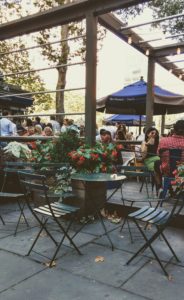
Feeling a bit depressed (actually, feeling a bit smelly), I continue by walking down 50th to 5th Avenue. Much of Wharton’s world centers on 5th Ave, but Lily’s presence on 5th at the end of the novel illustrates just how far removed she is — both literally and figuratively — from where she began. She is almost unrecognizable from the bright young woman who ran into Seldon at Grand Central Station. She has moved west of 6th Avenue, to a boarding house that is so run-down and dreary that she “dreaded” returning in the evening. The boarding house doesn’t exist, but I walk from Seldon’s imaginary 50th Street apartment down 5th Avenue, past high-end retailers and the public library and turn on 40th Street toward Bryant Park, the same walk Lily takes toward the end of the novel. She has just left Seldon’s apartment for the last time, after a perplexing goodbye where she admits to him:
“I have tried hard–but life is difficult, and I am a very useless person…I was just a screw or a cog in the great machine I called life, and when I dropped out of it I found I was of no use anywhere else. What can one do when one finds that one only fits into one hole? One must get back to it or be thrown out into the rubbish heap–and you don’t know what it’s like in the rubbish heap!”
Lily has failed at the complexities of life. She has learned that there is no place left in society for her; she has not fallen into her pre-determined role, she lacks the skills needed to survive in the working class, and that same society that she has spent her entire life conditioned for has discarded her like garbage. Lily leaves Seldon with the remaining fragment of her old self, and while again Seldon offers to help her, she sets out alone. For a moment Lily walks “unconscious of her surroundings…treading the buoyant ether which emanates from the high moments of life.” But this feeling passes, and the feeling of exhaustion returns to her — both mentally and physically — and “for a moment she felt that she could walk no farther.” In the cold, damp, darkness of Manhattan, she seeks refuge in Bryant Park where she remembered there were benches to rest.
The benches have been replaced with green folding chairs and cafe tables, and on this warm, summer afternoon, Bryant Park is crowded with locals and tourists clutching cold drinks and ice cream cones. But it’s easy for me to imagine Lily sitting there alone — perhaps because I, too, am a woman prone to sitting alone on benches. I buy an ice cream and find a single chair to re-read her tragic ending.
Lily is aware that she shouldn’t stay long in the cold but “her will-power seemed to have spent itself in a last great effort, and she was lost in the blank reaction which follows on an unwonted expenditure of energy. And besides, what was there to go home to?” Gone is the stand-out, energetic beauty from the novel’s beginning. Lily is near invisible and — perhaps just as important — unaware of (or perhaps apathetic to) this fact. It is true that: “One or two of these passers by slackened their pace to glance curiously at her lonely figure; but she was hardly conscious of their scrutiny.” The beautiful, proud, adaptable, sociable Lily Bart is gone, and in her solitude she is almost unrecognizable.
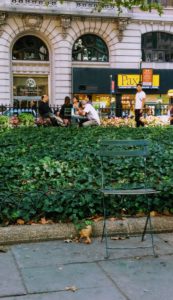
Next stop is (formerly) Trinity Chapel, the chapel where Edith Wharton got married. The Chapel was destroyed in a fire, but one wall remains. When I get there, there is fencing up around the address, but an open gate in the fence; several people are walking through, so I reason I can, too. I find the remaining original wall and aim my camera when a man stops me.
“What are you doing here?” he says.
“Isn’t this Trinity Chapel?” I say.
“Yes. You can’t be here.”
“One of my favorite writers got married here. I just want a quick picture.”
“No, you can’t be here.” He motions at the fencing.
“It would literally take me five seconds to take a photo.”
But five seconds is too long, and he leads me back to the sidewalk.
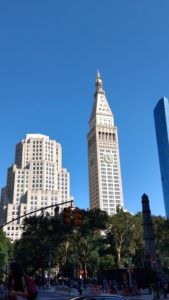
I’m a bit stunned. And annoyed. But I must admit that getting kicked out of the chapel-formerly-known-as-Trinity is somewhat amusing. so I continue wandering, my shoulders a bit more slumped, this time just a few blocks down to the house where Edith Wharton lived as a child.

Sadly, Edith Wharton’s childhood home is now a Starbucks. At least there’s a plaque. I take a few photos of it and just sort of stand there on the sidewalk, blinking at people rushing past me on their way to happy hour after work. “Don’t you people realize that Edith Wharton used to live here?” I want to say. “Edith Wharton. She won a Pulitzer.” But nobody seems to notice me or the plaque. I’m just another woman standing in front of just another Starbucks
.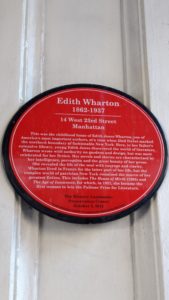
Defeated, I head toward Union Square subway. I manage to find an empty seat and sink gratefully into it. The woman next to me looks just as defeated as I do. But she sends me a smile.
“Glad it’s the weekend,” she says.
“Me too,” I say, nodding.
“You have a good one,” she says, sending me another smile.
This time, I smile back.
Epilogue: I drag my wilted body back to Brooklyn. I decide to grab a sandwich from a bakery on the walk back home from the subway. The cashier asks if I want an eclair. I tell her, No thank you.
“I was just going to give them to you,” she says. “We make them fresh in the morning, and I hate to throw them away.”
“Well, okay,” I say.
She hands me two eclairs, a chocolate and a pistachio. I save them for my breakfast, and they are both delicious.
Oh, New York. You spin me on a dime, and I love you.
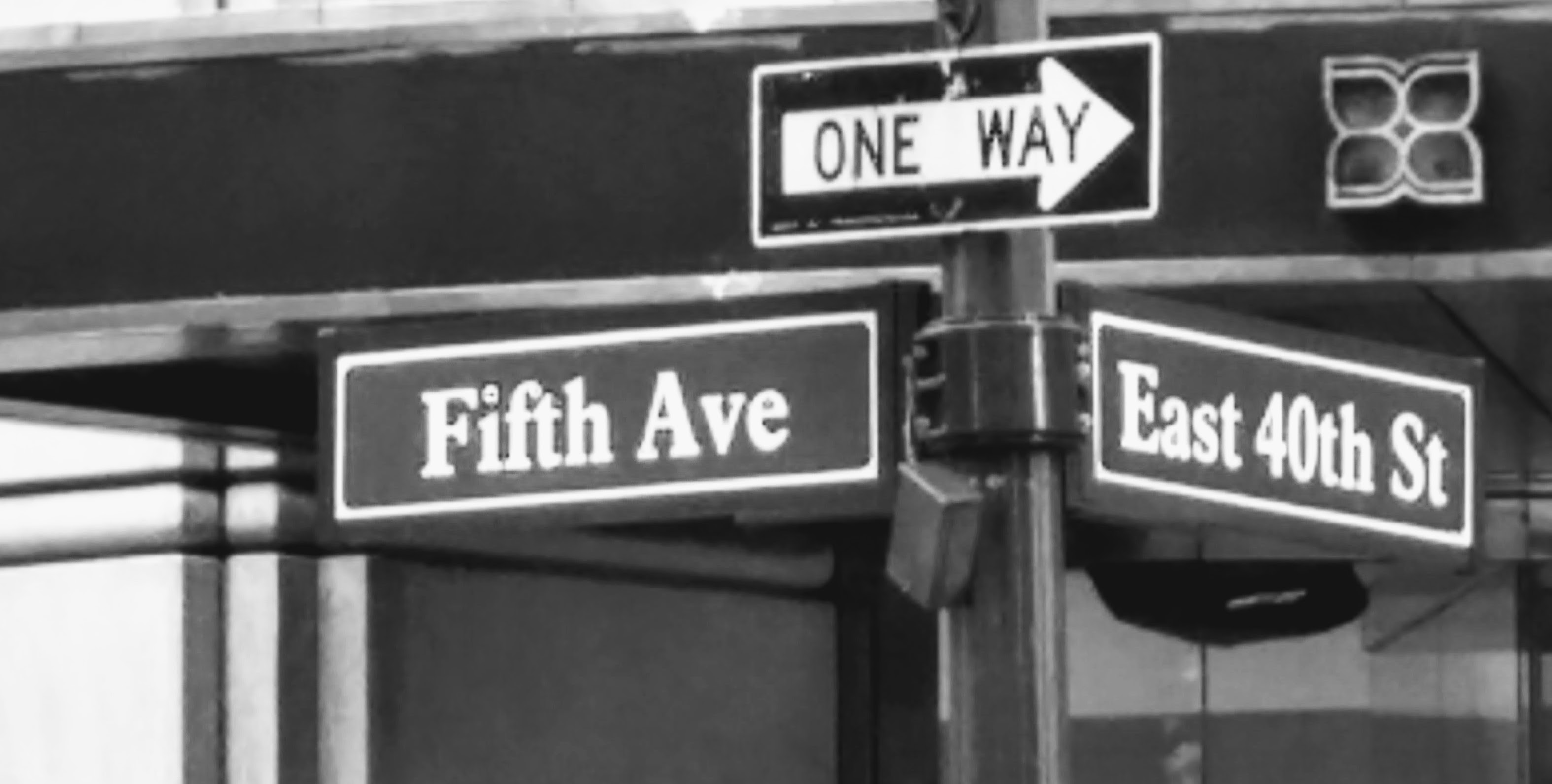






I love this! In hindsight, I think getting kicked out of Trinity Chapel was a very Lily-esque experience for you…so it kind of had to happen. And it makes a better story than if you just got to take your picture!
Yes, it does make for a better story! Always have to keep my eyes open for the story! (Plus, it led to free pastries, which is always a good thing….)